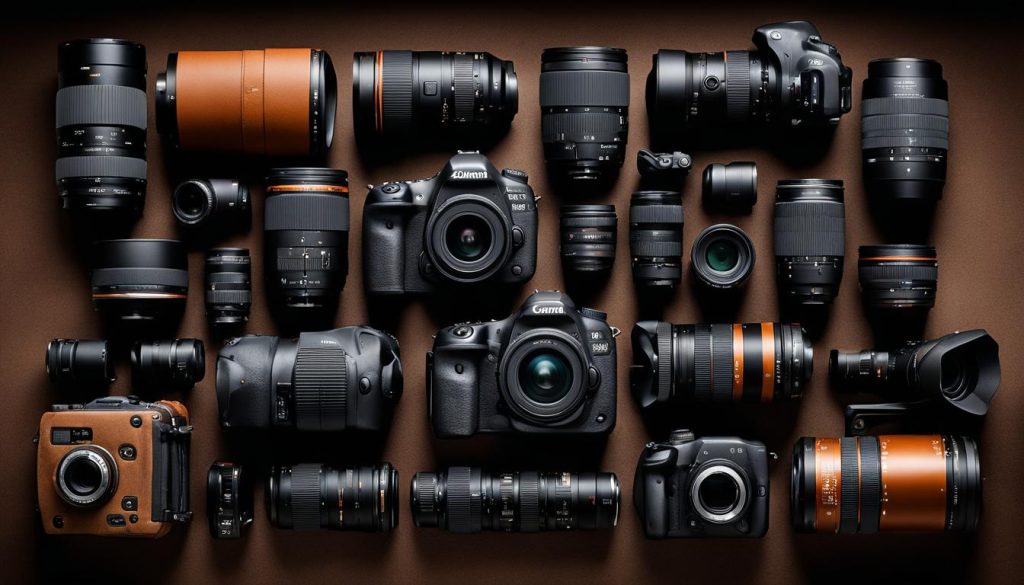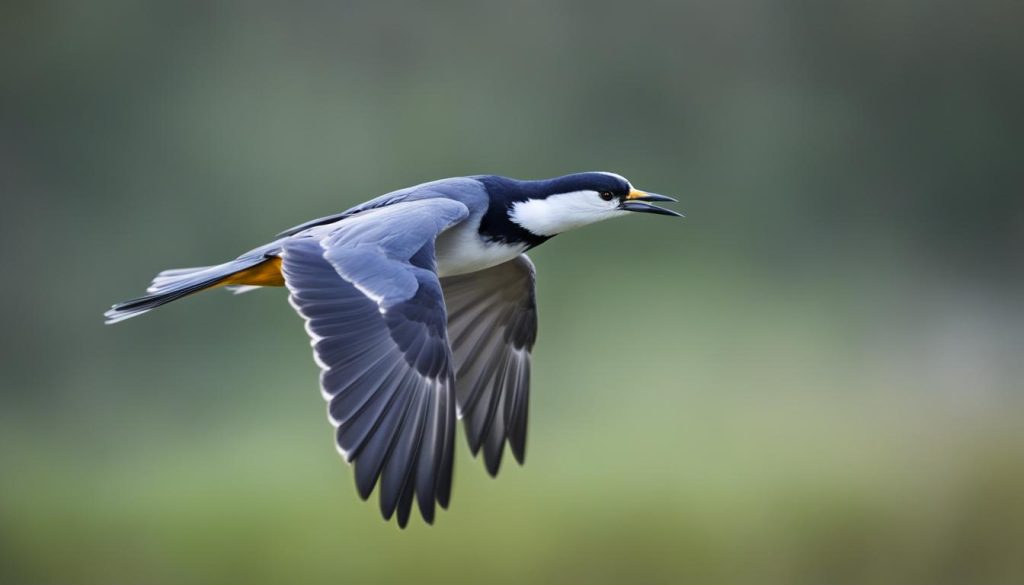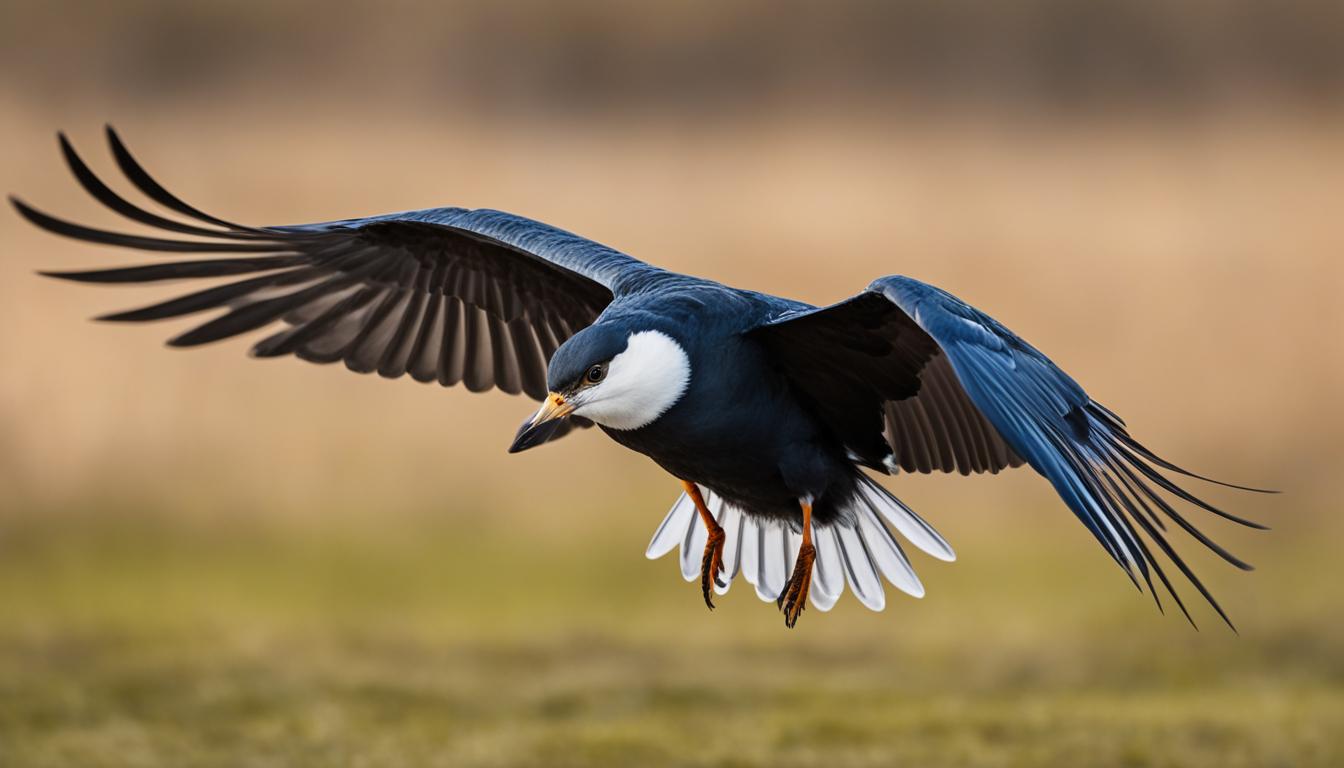Do you find yourself marveling at the gracefulness of birds in flight? Capturing these captivating moments with your camera can be an exhilarating experience. Birds in flight photography allows you to freeze their elegant movements and immortalize them in a still image. This article will provide you with expert tips and advice to enhance your bird in flight photography skills.
Key Takeaways:
- Mastering bird in flight photography requires practice and patience.
- Using a fast shutter speed is crucial to freeze the bird’s motion and capture sharp images.
- Continuous autofocus and burst mode help track the bird’s movement and increase your chances of getting a perfect shot.
- The right gear, such as a telephoto lens and a stable tripod, is essential for capturing distant birds and minimizing camera shake.
- Paying attention to composition and timing can greatly enhance the visual impact of your bird in flight photographs.
Tips for Photographing Birds in Flight
To successfully capture breathtaking shots of birds in flight, it’s essential to keep a few key tips in mind. These techniques will help you freeze the bird’s movement, maintain focus, and create stunning bird photography. Let’s dive into these tips and take your bird in flight photography to new heights!
- Quick Shutter Speed: Use a shutter speed of 1/1000 or faster to freeze the bird’s motion and ensure sharp focus. This fast shutter speed will help capture the intricate details of the bird in mid-flight.
- Continuous Autofocus and AI Servo Mode: Enable continuous autofocus and AI servo mode on your camera to track the bird’s movement and maintain focus as it soars through the sky. This will ensure that your subject remains in sharp focus throughout the entire flight.
- Aperture Selection: Stop down your aperture to around F/6.3 or higher to ensure that the entire bird is in focus. This depth of field setting is ideal for capturing the bird in sharp detail while still maintaining a pleasing background blur.
- Consider Lighting and Composition: Keep the sun at your back when photographing birds in flight. This lighting position will illuminate the bird and bring out the vibrant colors of its plumage. Additionally, consider the composition of your final image, framing the bird against a visually interesting background.
- High-Speed Burst Mode: Utilize your camera’s high-speed burst mode to capture a series of shots in rapid succession. This will increase your chances of capturing the perfect moment and result in sharp, dynamic images of birds in flight.
Expert Tip: “Capturing birds in flight requires a combination of technical skill and artistic vision. Experiment with different techniques and practice regularly to develop your own unique style of bird in flight photography.” – Jane Smith, Wildlife Photographer
By following these bird photography tips, you’ll be well on your way to capturing stunning images of birds in flight. Remember, practice makes perfect, so keep honing your skills and exploring the beauty of avian photography!
Related Articles:
- Bird Photography Techniques: How to Capture Birds in Their Natural Habitat
- The Art of Wildlife Photography: Secrets to Stunning Animal Portraits
Essential Gear Selection
When it comes to capturing breathtaking photos of birds in flight, having the right gear is essential. The following equipment will help you achieve the best results:
1. Camera
Invest in a camera with a fast autofocus system and a high burst rate. These features will allow you to effectively track the movement of birds and capture multiple shots in quick succession. Consider full-frame cameras for better low-light performance or crop sensor cameras to extend the effective focal length of your lenses.
2. Telephoto Lenses
Telephoto lenses are a must-have for bird in flight photography. Opt for lenses with focal lengths ranging from 300mm to 600mm or longer. These lenses will bring distant birds closer, allowing you to capture intricate details and stunning close-up shots. Remember, the longer the focal length, the more reach you’ll have.
3. Stabilization
Using a sturdy tripod or monopod is crucial for minimizing camera shake and achieving sharp images. This becomes especially important when using longer telephoto lenses, as they can be heavy and challenging to hold steady. Stabilization will ensure your shots are crisp and blur-free.

With the right camera, telephoto lenses, and stabilization equipment, you’ll have the necessary tools to capture stunning images of birds in flight. Remember to practice and experiment with different gear combinations to find what works best for you.
Camera Settings for Birds in Flight
When it comes to photographing birds in flight, understanding the right camera settings is essential to capture stunning images. Here are some key settings to consider:
- Shutter Speed: To freeze the bird’s motion and prevent blur, use a fast shutter speed. Aim for a minimum of 1/1000 or faster.
- Aperture: Setting the aperture to a wider value, such as F/4 or below, creates a shallow depth of field, isolating the bird from the background and making it the focal point.
- ISO: Adjust the ISO to maintain a fast shutter speed in different lighting conditions. Higher ISO values can be used in low-light situations, but be mindful of noise.
- Continuous Autofocus: Enable continuous autofocus mode to track the bird’s movement as it flies. This ensures that your subject remains in focus throughout the shot.
- Burst Mode: Shooting in burst mode allows you to capture a series of images in quick succession. This increases your chances of capturing the perfect moment with the bird in a desirable position.
By using the right combination of these camera settings, you can increase your chances of capturing sharp, dynamic images of birds in flight. Experiment with different settings and find what works best for your specific shooting conditions.
Remember, patience and practice are key to achieving the desired results. Don’t be afraid to adjust your settings as you gain more experience and adapt to different bird species and environments.

Mastering Composition and Timing
Composition and timing are crucial elements in capturing stunning bird in flight photographs. By applying specific composition techniques and being mindful of timing, you can create impactful and visually pleasing images.
Composition Techniques
Mastering composition techniques can greatly enhance the quality of your bird photography. Two essential techniques to consider are following the rule of thirds and incorporating leading lines. By dividing your frame into thirds and placing the bird along these lines or intersections, you create a visually balanced composition that draws the viewer’s eye. Additionally, incorporating leading lines, such as tree branches or the horizon, can guide the viewer’s gaze and add depth to your images.
“Composition is the foundation of a great photograph. It provides structure, balance, and visual interest. Don’t be afraid to experiment and think outside the box when composing your bird in flight photographs.”
Timing is Everything
Timing plays a critical role in capturing the perfect moment in bird in flight photography. By paying close attention to the bird’s behavior and flight trajectory, you can anticipate their movements and position yourself accordingly. Timing is particularly crucial when photographing mid-flight moments, such as when the bird’s wings are fully extended or when it’s executing a decisive turn. Patience and observation are key in mastering timing and capturing those awe-inspiring shots.
To further improve your timing, it can be helpful to familiarize yourself with the behavior patterns of different bird species. Understanding their flight patterns, hunting behaviors, and preferred habitats can give you an advantage in predicting their movements and positioning yourself for the best shots.
A Practical Approach
When it comes to composition and timing, practice is essential. Take the time to study the work of renowned bird photographers and analyze their composition choices and timing. Experiment with different angles, perspectives, and framing techniques to find what works best for you.
Consider the visual elements surrounding the bird, such as the background and foreground. These elements can either enhance or distract from the subject. Look for opportunities to include natural elements, such as flowers or branches, to add depth and interest to your photographs.
| Composition Techniques | Timing Tips |
|---|---|
| – Rule of thirds | – Study bird behavior |
| – Leading lines | – Anticipate movements |
| – Experiment with angles | – Capture mid-flight moments |
| – Consider foreground and background | – Practice patience and observation |
Remember, capturing stunning bird in flight photographs is a combination of technical skill and artistic vision. By mastering composition techniques, understanding timing, and practicing consistently, you can elevate your bird photography to new heights.
Bottom Line
Birds in flight photography is a thrilling pursuit that requires a combination of technical mastery and artistic vision. To capture stunning images of birds in motion, you need to be equipped with the right knowledge and tools. By understanding the essential camera settings, choosing the appropriate gear, and mastering composition and timing, you can elevate your bird in flight photography skills and create captivating images.
Patience and keen observation are key when photographing birds in flight. These majestic creatures have an unpredictable nature, making it essential for photographers to adapt swiftly to their ever-changing behavior. The ability to anticipate their movements and position yourself accordingly will greatly increase your chances of capturing the perfect shot.
When it comes to gear selection, invest in a camera with a fast autofocus system and a high burst rate. These features will enable you to effectively track moving birds and capture multiple shots in quick succession. Additionally, telephoto lenses with a focal length of 300mm or higher will help bring distant birds closer, allowing you to capture intricate details.
Proper camera settings are crucial for achieving sharp and well-exposed images. Use a fast shutter speed of at least 1/1000 to freeze the bird’s motion and prevent blurring. Adjust your aperture to a wider value, such as F/4 or below, to create a shallow depth of field and isolate the bird from the background. Experiment with different ISO settings to maintain an adequately fast shutter speed in various lighting conditions.
Composition plays a vital role in capturing compelling bird in flight photographs. Use the rule of thirds, leading lines, and other compositional techniques to create visually pleasing images. Timing is equally important, as it allows you to capture unique moments in a bird’s flight, such as when their wings are fully extended or when they execute intricate maneuvers.
Remember, bird in flight photography is a craft that requires practice and dedication. Continue honing your skills, experimenting with different techniques, and embracing the beauty and unpredictability of nature. The more you immerse yourself in this thrilling pursuit, the more rewarding your bird in flight photographs will become.
| Tips for Capturing Birds in Motion |
|---|
| 1. Use a fast shutter speed of at least 1/1000 to freeze the bird’s motion. |
| 2. Set your aperture to a wider value, like F/4 or below, to create a shallow depth of field. |
| 3. Experiment with different ISO settings to maintain a fast shutter speed in varying lighting conditions. |
| 4. Invest in a camera with a quick autofocus system and a high burst rate. |
| 5. Use telephoto lenses with a focal length of 300mm or higher to capture distant birds. |
| 6. Pay attention to composition techniques, such as the rule of thirds and leading lines. |
| 7. Anticipate the bird’s movements and position yourself accordingly for better timing. |
Conclusion
Capturing birds in flight is a challenging but rewarding aspect of wildlife photography. With the right techniques, gear, and patience, you can capture stunning images of birds in motion.
Remember to use a fast shutter speed to freeze the bird’s movement and ensure sharp shots. Continuous autofocus and burst mode will help you track the bird and increase your chances of capturing the perfect moment.
Pay attention to composition and timing to create visually appealing images. Consider the rule of thirds and leading lines to enhance your composition. Anticipate the bird’s behavior and capture their mesmerizing flight patterns at the right moment.
Keep practicing and refining your skills to improve your bird in flight photography. The more you practice, the better you will become at capturing those breathtaking shots. Enjoy the process and embrace the unpredictability of nature as you embark on this exciting photographic journey.
FAQ
What is bird in flight photography?
Bird in flight photography is the art of capturing images of birds while they are in mid-flight. It requires specialized techniques, gear, and patience to freeze the bird’s movement and capture sharp, dynamic shots.
Why is bird in flight photography challenging?
Bird in flight photography is challenging because birds are fast-moving subjects that can change direction quickly. It requires the right camera settings, gear, and timing to capture the perfect moment.
What camera settings are important for bird in flight photography?
Important camera settings for bird in flight photography include using a fast shutter speed to freeze the bird’s motion, a wide aperture to create a shallow depth of field, and continuous autofocus with burst mode to track the bird’s movement and increase your chances of getting a sharp image.
What gear is recommended for bird in flight photography?
Recommended gear for bird in flight photography includes a camera with a fast autofocus system and high burst rate, telephoto lenses ranging from 300mm to 600mm or longer to bring distant birds closer, and a sturdy tripod or monopod to stabilize your camera while shooting.
How can I improve my composition and timing in bird in flight photography?
To improve composition, you can follow the rule of thirds and incorporate leading lines to create visually pleasing shots. Timing can be improved by observing the bird’s behavior and flight trajectory, anticipating their movements, and positioning yourself accordingly to capture the perfect mid-flight moment.






